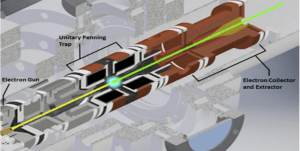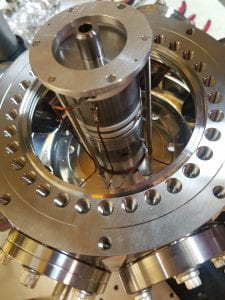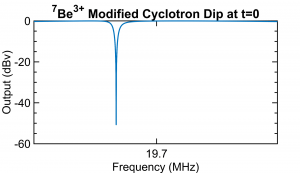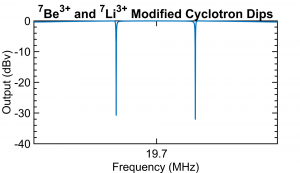
Graduate student Ariana Shearin and the CURIE Beam Line
The Cryogenic Ultrahigh vacuum Radioactive Ion Experiment (CURIE) Trap is a precision Penning ion trap for studying the decay of electron capture radioisotopes. Electron capture is a radioactive decay mode in which an unstable nucleus captures an inner-shell electron, when positron emission is energetically forbidden.
One of the main goals of this experiment is to measure, for the first time, perturbations in the half-life of ionized 7Be. 7Be is the lowest-Z isotope to decay 100% by electron-capture, with a natural half life of ~53 days. The decay rate depends on the electron wavefunction overlap with the nucleus and, therefore, can be perturbed. Many experiments have demonstrated 1-2% variations in the decay rate when 7Be is implanted in different chemical compounds. It is hypothesized that hydrogen-like 7Be (7Be3+) will exhibit a half life of ~103 days, but this has yet to be experimentally verified.
These measurements involve the integration of three, specialized sub-systems: An EBIT source for generating ions, a beam transport line, an a high-field cryogenic Penning ion trap.
Electron Beam Ion Trap (EBIT)

To generate all four ionization states of 7Be, we utilize a room-temperature miniature Electron Beam Ion Trap. This device uses an electron beam to ionize neutrals through electron impact ionization. The generated ions are temporarily stored in a unitary Penning ion trap before being ejected at ~3 keV/q. In the case of 7Be, it is introduced into the device by laser ablation of a thin target, using an Nd:YAG laser. An artistic rendering of this process, superimposed over a CAD model of the EBIT internal structure is provided below.
Beam Transport Line

A beam transfer line consisting of electrostatic focusing/steering elements as well as a Wien filter is used to inject ions into a high field Penning trap for measurement. Because the EBIT will generate all four ionization states of 7Be, as well as contaminant ions, it is necessary to filter out the undesired charge states.
To prepare a ‘pure’ ion ensemble for injection into the high-field Penning ion trap comprised only of specific charge states, we utilize a commercial Wien (velocity) filter, which separates ions by their charge to mass (q/m) ratio. Additionally, a set of modified Einzel lenses is used to focus the beam and perform steering corrections.
Cryogenic Penning ion trap
The crux of this experiment is a high-field Penning ion trap, cryogenically cooled to 4 K. A Penning trap is device that uses a quadrupole electric field and a uniform magnetic field to confine ions. Cooling the trap to 4 K serves two primary purposes:
1. At 4 K all background gases (except for hydrogen and helium) will condense out of the trap vacuum chamber. Therefore, the chamber itself behaves as a cryopump and it is possible to achieve a vacuum better than E-15 Torr. In this regime, it is possible to store ion ensembles for months to years, making the desired half life measurements possible.
2. It will cool the ions’ motion to 4 K which allows for higher precision measurements.
An ion oscillating in the trap will induce a small image current (~5 fA) in the trap electrodes. By coupling a trap electrode to an external resonant circuit, it is possible to non-destructively detect the number of ions in the trap. When the ions are on resonance and in thermal equilibrium with the external circuit, the ions induce a dip in the circuit’s noise spectrum. The width of this dip is linearly proportional to the number of stored ions. An experiment to measure the half life of 7Be would appear as follows: Initially, a pure sample of 7Be3+ is contained in the trap (depicted by a single dip in the first figure below). As time evolves, the ions decay to 7Li3+, generating a second dip. Ultimately, after several half-lives, all 7Be3+ has decayed and only a 7Li3+ dip remains.
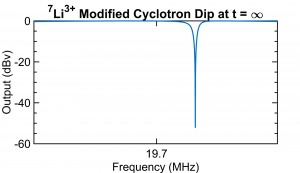
The Penning trap enables long-term storage and non-destructive interrogation of ions.
Below is a rendering of the full system design to date.


